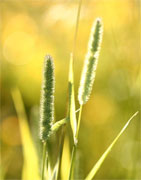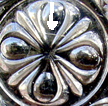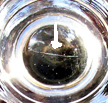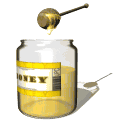 |
Let's Talk Straw - marks |
| And the first thing we will learn is that "Straw Marks" is an antique phrase meaning nothing. It is left over from an "old husbands tale" about testing the glass to see if its hardened by laying a piece of straw on it. WRONG - O |
 |
What folks really mean when they use that term is a "Shear Line". These are the often-seen irregular lines in old glass and here's how they get there. |  |
| Visualize a gather of glass at the end of a long metal pole that a glass maker is going to manipulate into something more useful than its present blob state. The glass maker dips the pole into a pot of hot molten glass, called "metal". |
| The red-hot glass adheres to the pole like honey to a honey stick. The pole with attached glass is transported to a mold and a metal shear (scissors, if you will) is used to cut off just the right amount of glass that is starting to drip off the metal pole because of gravity (the technical term for this is "a big droopy glob"). |  |
| The shears are room temp (about 100 degrees) and the glass metal is around 2000-2500 degrees. Where the shears snip the glass, (think cutting taffy with scissors) makes the glass at the point of contact cool slightly. It puckers & pulls together at the snip spot. That cool spot is still on the glass as it falls into the mold. The press comes down and fills the glass into the nooks and crannies of the mold. The plunger is removed and that shear line has been flattened out and is now somewhere in the area that the plunger pushed down. In a bowl, it is usually found on the inside of the bowl, but it could be anywhere. It is usually 1-3" long depending on the size of the gather that was snipped. It does not reflect light so it shows up as a line and the little groove can be felt when you run your fingernail over it. |
| And THAT, my friends is the story of a Shear Line! |
| Thanks and a tip of the PatternGlass.com Hat
to "Mr. Vaseline", Dave Peterson (formerly of Oklahoma) for his scholarly explanation of this often confusing phenomenon. |





